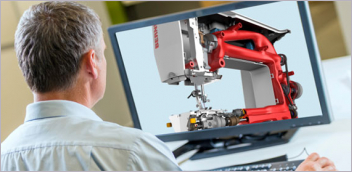DE News Roundup: November 16, 2018
3D printing study on particle emission risk, Autodesk improves generative design, PLM midrange players consolidate, and more
Latest News
November 16, 2018
Study Warns of Hazardous 3D Printer Emissions
Some types of 3D printers produce potentially dangerous emissions, including ultrafine particles (UFPs) and volatile organic compounds (VOCs), according to the research published by Underwriters Laboratories and the Georgia Institute of Technology.
According to the study, many desktop 3D printers generate ultrafine particles while in operation. These particle are the size of nanoparticles and can be inhaled into the human pulmonary system. The research also identified more than 200 different volatile compounds, released during the operation of some 3D printers.
The current phase of research is focused on fused filament deposition printers, commonly used in offices, libraries, and schools.
Factors such as nozzle temperature, filament type, filament and printer brand, and filament color, and even extrusion temperature may affect the level of emission, the study states.
The study includes some good suggestions on how to minimize the emission’s impact, such as:
- Operating 3D printers only in well-ventilated areas;
- Setting the nozzle temperature at the lower end of the suggested temperature range for filament materials;
- Standing away from operating machines;
- Using machines and filaments that have been tested and verified to have low emissions.
For more on this, please go to DE’s article titled “UL Study Identifies Hazardous 3D Printer Emissions,” now inline at DE 247—that’s digitalengineering247.com.
Autodesk Adds More Manufacturing Constraints to Generative Design in Fusion 360
Autodesk’s annual user conference for this year, Autodesk University 2018, is wrapping up now in Las Vegas. At the show, the company highlighted how generative design is integrated into the Autodesk Fusion software product, a cloud-enabled design solution that includes CAD, CAM, and simulation.
Generative design software uses a combination of time-tested simulation methods and machine learning in the background to generative optimal shapes based on user input, such as loads, stresses, and materials.
One of the hiccups with this approach is, the computer-generated shapes often turn out to be impractical or impossible to produce using traditional methods, such as machining or milling.
According to the show’s keynote, the company is now adding support for more types of manufacturing constraints—2- and 2.5-axis machining in addition to the existing 3D printing and 3- and 5-axis milling. That means, the shape generated by the software is more suitable for these production methods, because the software’s algorithms will consider the requirements—what works and what doesn’t—for these approaches in its shape generation procedures.
Generative Design is the topic of our next roundtable discussion. To register, go here.
Arena Solutions Acquires Omnify Software
This week, cloud-hosted PLM vendor Arena Solutions bought Omnify, another vendor in the same market. This comes soon after Arena announced it is opening offices in Austin, Texas, and Suzhou, China, pointing to the company’s growth.
The new branch in China will support Arena Solution's software development efforts at its home office in Foster City, Calif., the company clarifies.
Arena attributes its growth specifically to the IoT sector in its new office announcement.
Omnify is based in Andover, Mass, with a large customer base that includes electronics, medical devices, aerospace and defense, and telecommunications markets—customers that will now become Arena customers.
Another point of synergy is both companies offer PLM solutions that are web-cased, cloud-hosted, making their offerings complementary.
The PLM market is dominated by a number of large players, including Dassault Systemes, Siemens PLM Software, PTC, SAP, and Oracle. Companies like Arena with cloud-hosted, easy to deploy, lower cost PLM solutions are particularly attractive to small and midsized firms that feel the larger PLM systems are overly complex and too costly to deploy and maintain for what they need.
The Arena-Omnify merger signifies the PLM marketplace consolidation cycle that once led to the emergence of the current top players are now also happening among the midrange providers.
3D Prints RF Amplifiers Using Nano Dimension’s DragonFly Pro
Can you 3D-print a radio frequency amplifier, complete with circuitry and conductive materials? The question has been settled by Nano Dimension, the company that makes a 3D printer called DragonFly.
3D printers can print in a variety of soft, stiff, and even metallic materials. Some can also mix different materials in a single print job, to produce objects like shoes with different textures and stiffness in different parts.
But printing small objects with embedded electronics and circuitry brings the technology to a new level, opening the possibility that, in the future, some consumer goods with electronics may not need to be assembled but instead printed in as a single part.
The Nanodimension’s project to print RF amplifiers was done in collaboration with Harris Corporation, a company that supplies electronics, communication systems, and space and intelligence systems to government, military, and commercial customers.
The company reveals that they use the DragonFly Pro for the print a the functional RF amplifier as a single print, and then components were manually soldered to the PCB (printed circuit board).
More Autodesk Coverage
Subscribe to our FREE magazine, FREE email newsletters or both!
Latest News
About the Author
Kenneth Wong is Digital Engineering’s resident blogger and senior editor. Email him at kennethwong@digitaleng.news or share your thoughts on this article at digitaleng.news/facebook.
Follow DE






